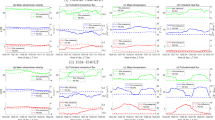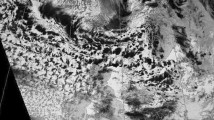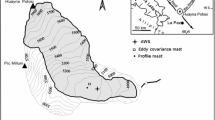Abstract
Air temperature time series within and above canopies reveal ramp patternsassociated with coherent eddies that are responsible for most of thevertical transport of sensible heat. Van Atta used a simple step-changeramp model to analyse the coherent part of air temperature structurefunctions. However, his ocean data, and our own measurements for aDouglas-fir forest, straw mulch, and bare soil, reveal that even withoutlinearization his model cannot account for the observed decrease of thecubic structure function for small time lag. We found that a ramp model inwhich the rapid change at the end of the ramp occurs in a finite microfronttime can describe this decrease very well, and predict at least relativemagnitudes of microfront times between different surfaces. Averagerecurrence time for ramps, determined by analysis of the cubic structurefunction with the new ramp model, agreed well with values determined usingthe Mexican Hat wavelet transform, except at lower levels within theforest. Ramp frequency above the forest and mulch scaled very well withwind speed at the canopy top divided by canopy height. Within the forest,ramp frequency did not vary systematically with height. This is inaccordance with the idea that large-scale canopy turbulence is mostlygenerated by instability of the mean canopy wind profile, similar to aplane mixing layer. The straw mulch and bare soil experiments uniquelyextend measurements of temperature structure functions and ramp frequencyto the smallest scales possible in the field.
Similar content being viewed by others
References
Brunet, Y. and Raupach, M. R.: 1987, 'A Simple Renewal Model for Transfer in Plant Canopies', in Flow and Transport in the Natural Environment: Advances and Application. Poster Abstracts, International Symposium, Canberra, Aug. 31-Sept. 4, P4, 2 pp.
Chen, W. J., Novak, M. D., Black, T. A., and Lee, X.: 1997, 'Coherent Eddies and Temperature Structure Functions for Three Contrasting Surfaces. Part II: Renewal Model for Sensible Heat Flux', Boundary-Layer Meteorol. 84, this issue.
Collineau, S. and Brunet, Y.: 1993a, 'Detection of Turbulent Coherent Motions in a Forest Canopy, Part I: Wavelet Analysis', Boundary-Layer Meteorol. 65, 357–379.
Collineau, S. and Brunet, Y.: 1993b, 'Detection of Turbulent Coherent Motions in a Forest Canopy, Part II: Time-Scales and Conditional Averages', Boundary-Layer Meteorol. 66, 49–73.
Gao, W., Shaw, R. H., and Paw U, K. T.: 1989, 'Observation of Organized Structure in Turbulent Flow Within and Above a Forest Canopy', Boundary-Layer Meteorol. 47, 349–377.
Lee, X. and Black, T. A.: 1993, 'Atmospheric TurbulenceWithin and Above a Douglas-fir Stand. Part I: Statistical Properties of the Velocity Field', Boundary-Layer Meteorol. 64: 149–174.
Liu, J., Chen, J. M., Black, T. A., and Novak, M. D.: 1996, ‘Е—ε Modelling of Turbulent Air Flow Downwind of a Model Forest Edge’, Boundary-Layer Meteorol. 77, 21–44.
Orchansky, A.L., Lee, X., and Novak, M. D.: 1994, 'Miniature HotWireAnemometer toMeasureVery Low Wind Speeds', Preprints, 21st AMS Conference on Agricultural and Forest Meteorology, San Diego, CA, Mar. 7-11, pp. 201–202.
Paw U, K. T., Brunet, Y., Collineau, S., Shaw, R. H., Maitani, T., Qiu, J., and Hipps, L.: 1992, 'Evidence of Turbulent Coherent Structures in and above Agricultural Plant Canopies', Agric. For. Meteorol. 61, 55–68.
Paw U, K. T., Qiu, J., Su, H. B., Watanabe, T., and Brunet, Y.: 1995, 'Surface Renewal Analysis: A New Method to Obtain Scalar Fluxes without Velocity Data', Agric. For. Meteorol. 74, 119–137.
Qiu J., Paw U, K. T., and Shaw, R. H.: 1995, 'Pseudo-Wavelet Analysis of Turbulence Patterns in Three Vegetation Layers', Boundary-Layer Meteorol. 72, 177–204.
Raupach, M. R., Antonia, R. A., and Rajagopalan, S.: 1991, 'Rough-Wall Turbulent Boundary Layers', Appl. Mechanics Revs. 44, 1–25.
Raupach, M. R., Finnigan, J. J., and Brunet, Y.: 1989, 'Coherent Eddies in Vegetation Canopies', in Proceedings of the Fourth Australian Conference on Heat and Mass Transfer, Christchurch, NZ, pp. 75–90.
Raupach, M. R., Finnigan, J. J., and Brunet, Y.: 1996, 'Coherent Eddies in Vegetation Canopies: The Mixing-Layer Analogy', Boundary-Layer Meteorol. 78, 351–382.
Shaw, R. H., Brunet, Y., Finnigan, J. J., and Raupach, M. R.: 1995, 'A Wind Tunnel Study of Air Flow in Waving Wheat: Two-Point Velocity Statistics', Boundary-Layer Meteorol. 76, 349–376.
Spano, D., Duce, P., Snyder, R. L., and Paw U, K. T.: 1996, 'Verification of Structure Function Approach to Determine Sensible Heat Flux Density using Surface Renewal Analysis', Preprints, 22nd AMS Conference on Agricultural and Forest Meteorology, Atlanta, GA, Jan. 28-Feb. 2, pp. 163–164.
Van Atta, C. W.: 1977, 'Effect of Coherent Structures on Structure Functions of Temperature in the Atmospheric Boundary Layer', Arch. Mech. 29, 161–171.
Author information
Authors and Affiliations
Rights and permissions
About this article
Cite this article
Chen, W., Novak, M.D., Black, T.A. et al. Coherent eddies and temperature structure functions for three contrasting surfaces. Part I: Ramp model with finite microfront time. Boundary-Layer Meteorology 84, 99–124 (1997). https://doi.org/10.1023/A:1000338817250
Issue Date:
DOI: https://doi.org/10.1023/A:1000338817250




